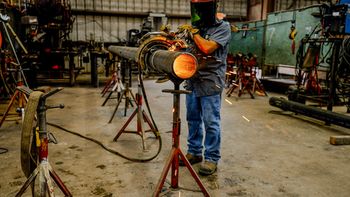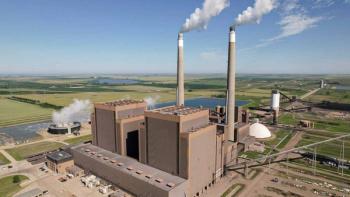
HRSG Duct Liners: Keeping the Heat In
HRSG inlet duct liners minimize unwanted heat loss to increase efficiency.
The exhaust gas from the combustion turbines of a combined-cycle power plant may reach or exceed 1000oF. Even higher temperatures of up to 1350oF are possible if the heat recovery steam generator (HRSG) inlet duct(s) has duct burners. Critical aspects for unit efficiency, and perhaps at times for personnel safety, are the correct design and installation of internal duct liners to maximize heat retention within the duct.
Duct Liner Materials and Basic Design
Each duct liner consists of three major components:
- Thermal insulation (ceramic fiber), where the insulation thickness is calculated from the exhaust gas temperature and the required temperature of the outer duct plate.
- Studs or scallop plates for insulation and liner sheet attachment and support.
- Liner sheets protect the insulation (FIGURE 1) from the combustion turbine exhaust gas flow.
Ceramic fiber is a highly efficient insulating material. Additional items that require careful evaluation and installation are mounting/support brackets for the insulation and internal liner sheets that protect the insulation from the dynamic environment. Floating liners have the strength to withstand the flue gas flow and can thermally expand without constraint (FIGURE 2).
Each application must be accurately evaluated or determined for the following:
- Desired or required outer duct temperature
- Insulation type, thermal conductivity, and thickness
- Liner sheet thickness
- Support structures for the insulation and liner sheets: studs and scallop plates
- Spacing between studs or scallop plates
- Stud diameter
- Welding procedures
These details can be determined by both past experiences and analysis tools such as computational fluid dynamics (CFD).
CFD data helps to pinpoint locations of maximum flow, which in turn may require adjustments to design parameters that are otherwise acceptable for other locations in the system.
Inspection and Maintenance Issues
To improve performance and repair damaged equipment, inspect existing systems and make modifications accordingly. A first step is often thermal imaging of the duct from all sides. Thermal images (FIGURE 4) are then utilized to install or repair insulation at “weak” locations. These weak spots may come as a result of equipment degradation over time from the harsh environment.
A major problem in this regard can be the expansion and contraction of the internal liner sheets that occur from the frequent load cycling of many combined-cycle units. The floating liner helps to alleviate that difficulty.
Another issue could be the result of poor equipment installation. FIGURE 2 illustrates a precise pattern for stud location. Compare that with FIGURE 5 below from an existing unit.
It does not seem that much if any science was utilized in this pattern. The welding techniques appear to be haphazard as well. Welding is an extremely critical issue for many industrial equipment items. Welds are often prime locations for induced stress if not performed properly and with the correct filler materials. Conversely, FIGURE 6 illustrates the precise stud alignment in a relining project. It may be possible to prefabricate some sections to lower project or repair costs (FIGURE 7).
Conclusion
Maximizing unit efficiency is paramount as many countries move toward reduced CO2 emissions. A key factor in this effort is minimizing unwanted heat loss. Homeowners do this by adding insulation and sealing cracks around windows and doors—the same general principle applies to HRSG duct work. A significant amount of heat can escape if insulation is installed incorrectly or when operation causes failures.
Brad Buecker is a contributing editor for SVI BREMCO. He has over 40 years of experience in or supporting the power industry, nearly half of it in steam generation chemistry, water treatment, and air quality control.
Newsletter
Power your knowledge with the latest in turbine technology, engineering advances, and energy solutions—subscribe to Turbomachinery International today.




